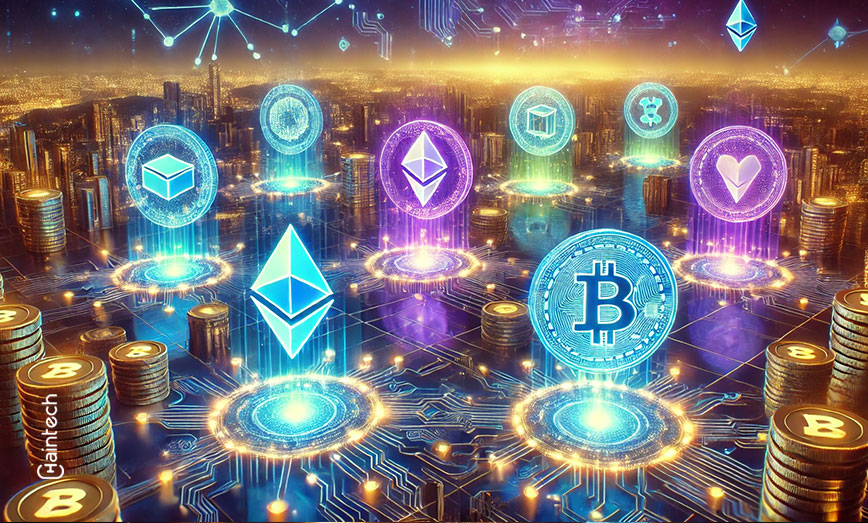The Straightforward Guide to Understanding Asset Tokenization

Introduction to Asset Tokenization
Asset tokenization refers to the process of converting real-world assets into digital tokens that can be traded and stored on a blockchain or distributed ledger technology (DLT) platform. This innovative concept combines the benefits of traditional assets with the security and efficiency of blockchain technology. By creating digital representations of assets such as real estate, stocks, commodities, intellectual property, and art, asset tokenization opens up new opportunities for investors and businesses alike.
Asset tokenization offers several key benefits. First and foremost, it allows for increased liquidity and accessibility. By breaking down assets into smaller units represented by tokens, investors have the ability to buy, sell, and trade fractions of assets that were previously illiquid. This level of divisibility also opens up new investment opportunities, allowing individuals with smaller budgets to participate in asset ownership.
The evolution and growth of asset tokenization have been remarkable. In recent years, this innovative concept has gained traction in various industries and has seen significant advancements thanks to the continuous development of blockchain technology and the increasing adoption of cryptocurrencies. From its initial application in the real estate sector to its expansion into other asset classes, asset tokenization is revolutionizing the way we perceive and interact with traditional assets.
Types of Assets that can be Tokenized
Asset tokenization is applicable to a wide range of assets, bringing the benefits of tokenization to various industries. Some examples of assets that can be tokenized include:
A. Real estate: Tokenizing real estate properties allows for fractional ownership, making large, valuable properties accessible to a broader pool of investors. It also increases liquidity in the real estate market, creating new investment opportunities and facilitating property transactions.
B. Stocks and equities: By tokenizing stocks and equities, traditional financial instruments become more accessible and can be traded 24/7, eliminating the need for intermediaries and reducing settlement times.
C. Commodities: Tokenizing commodities like gold, oil, or agricultural products provides investors with the ability to trade fractions of these assets. This not only increases liquidity but also offers a convenient way to diversify investment portfolios.
D. Intellectual property: Asset tokenization allows for fractional ownership of intellectual property, such as patents or copyrights. This enables creators to monetize their IP and investors to participate in their potential revenue streams.
E. Art and collectibles: Tokenizing art and collectibles offers a solution to the challenges of authenticity, provenance, and fractional ownership. It allows art enthusiasts to invest in high-value pieces and increases the liquidity of the art market.
The Process of Asset Tokenization
The process of asset tokenization involves several steps, each of which plays a crucial role in successful implementation:
A. Identifying the asset to be tokenized: The first step is to choose the asset that will be tokenized. This can be any physical or digital asset that holds value.
B. Legal and regulatory considerations: Before tokenizing an asset, it is important to understand and comply with applicable legal and regulatory requirements. This ensures that the tokenization process adheres to established standards and mitigates potential risks.
C. Tokenization platforms and technologies: Selecting a suitable tokenization platform or technology is essential for securely creating, managing, and trading asset tokens. These platforms provide the necessary infrastructure and tools to facilitate asset tokenization.
D. Issuing and distributing tokens: Once the asset has been tokenized, the tokens representing fractional ownership or rights are issued and distributed to investors. This process ensures transparency, traceability, and accountability throughout the entire lifecycle of the asset.
Benefits and Opportunities of Asset Tokenization
Asset tokenization offers numerous benefits and opportunities for investors, businesses, and various industries:
A. Increased liquidity and accessibility: Tokenizing assets allows for fractional ownership, making traditionally illiquid assets more accessible. It also introduces liquidity into markets that were previously restricted by high entry barriers.
B. Fractional ownership and investment opportunities: Asset tokenization enables investors to own fractions of high-value assets, diversify portfolios, and participate in markets that were previously reserved for large investors.
C. Reduction of intermediaries and costs: By utilizing blockchain technology and smart contracts, asset tokenization eliminates the need for intermediaries, such as brokers or custodians, reducing costs and increasing efficiency.
D. Lower entry barriers for investors: Tokenization enables investors with limited budgets to enter markets traditionally reserved for high-net-worth individuals. This democratization of investment opportunities promotes financial inclusion and widens access to wealth accumulation.
E. Funding opportunities for businesses: Asset tokenization provides businesses with an alternative fundraising method. By issuing security tokens, companies can raise capital and offer investors fractional ownership in their assets or revenue streams.
Challenges and Considerations in Asset Tokenization
While asset tokenization presents significant opportunities, it also comes with its own set of challenges and considerations that need to be addressed:
A. Legal and regulatory challenges: The legal and regulatory landscape surrounding asset tokenization is still evolving. Different jurisdictions have varying approaches and requirements, creating a complex compliance environment.
B. Security and fraud risks: As with any digital asset, the risk of cybersecurity threats, hacking, and fraud is a concern in asset tokenization. Implementing robust security measures and ensuring compliance with industry standards are crucial to mitigate these risks.
C. Privacy and data protection issues: Tokenizing assets involves collecting and storing sensitive personal and financial data. Implementing robust data protection measures and adhering to privacy regulations is essential to protect investors’ information.
D. Market volatility and liquidity concerns: The tokenization of assets introduces new challenges related to market volatility and liquidity. Token holders should carefully evaluate the liquidity of an asset before investing and be aware of the potential impact of market fluctuations on token prices.
E. Adoption and acceptance challenges: Despite the numerous benefits, asset tokenization still faces challenges regarding adoption and acceptance. Stakeholders need to actively collaborate to create awareness, education, and establish trust in this relatively new and evolving technology.
Real-World Use Cases of Asset Tokenization
Asset tokenization has already shown success in various real-world applications:
A. Tokenization of real estate properties: Real estate, being a traditionally illiquid asset class, benefits greatly from tokenization. It allows for fractional ownership, increased liquidity, and facilitates property transactions.
B. Fractionalization of artworks: Tokenizing artworks provides investors with the opportunity to own fractions of valuable pieces. It also improves transparency, provenance tracking, and simplifies the art market.
C. Tokenized investment funds: Asset tokenization enables the creation of investment funds that offer fractional ownership to investors. This opens up new avenues for diversification and allows for increased flexibility in managing investment portfolios.
D. Tokenization of intellectual property rights: Through asset tokenization, the ownership and licensing of intellectual property can be divided into shares. This empowers creators to monetize their IP while allowing investors to participate in potential revenue streams.
Tokenizing Assets on the Blockchain
A. How blockchain technology enables asset tokenization: Blockchain technology provides a decentralized and transparent platform for asset tokenization. It ensures the secure recording of transactions, immutability of data, and enables peer-to-peer trading without the need for intermediaries.
B. Advantages and limitations of blockchain for asset tokenization: Blockchain offers advantages such as increased security, reduced transaction costs, enhanced transparency, and improved efficiency. However, limitations exist, including scalability issues and the need for regulatory frameworks to catch up with technological advancements.
Exploring Tokenization Platforms and Projects
A. Overview of prominent tokenization platforms: Several platforms are paving the way for asset tokenization, including Polymath, Harbor, and Securitize. These platforms provide the necessary infrastructure and tools for asset tokenization and compliance with securities regulations.
B. Case studies of successful asset tokenization projects: Numerous successful asset tokenization projects have emerged across various industries. Examples include the tokenization of the St. Regis Aspen Resort and the Andy Warhol painting, “14 Small Electric Chairs.”
Regulatory Landscape and Compliance
A. Global regulatory approaches to asset tokenization: Regulatory approaches vary globally, with some jurisdictions embracing asset tokenization and others adopting a cautious approach. It is important for entities involved in asset tokenization to navigate the regulatory landscape to ensure compliance.
B. Compliance standards and legal frameworks: Compliance standards and legal frameworks evolve to keep pace with asset tokenization. Entities involved should stay informed about regulations, such as Know Your Customer (KYC), Anti-Money Laundering (AML), and securities laws to ensure compliance.
The Future of Asset Tokenization
Asset tokenization has a promising future and is expected to impact financial markets and industries in several ways:
A. Predictions and trends for asset tokenization: The market for asset tokenization is projected to grow significantly in the coming years. Predictions include increased adoption across industries, further regulatory clarity, and the emergence of new tokenization standards.
B. Potential impact on financial markets and industries: Asset tokenization has the potential to disrupt traditional financial markets and empower various industries. It enables new investment models, reduces barriers to entry, and facilitates the seamless transfer of assets.
C. Innovations and advancements in tokenization technology: With ongoing advancements in blockchain technology, tokenization platforms are continuously innovating and improving their functionality. This will contribute to a more streamlined and user-friendly asset tokenization experience.
Summary
Asset tokenization is a groundbreaking concept that allows for the conversion of real-world assets into digital tokens on a blockchain platform. It offers various benefits, including increased liquidity, fractional ownership, and reduced intermediaries. However, challenges such as legal complexities, security risks, and market volatility need to be addressed. Real-world use cases demonstrate the potential of asset tokenization across industries, while blockchain technology plays a vital role in enabling secure and transparent transactions. As the regulatory landscape evolves and adoption increases, asset tokenization is poised to revolutionize financial markets, empower investors, and transform industries.









